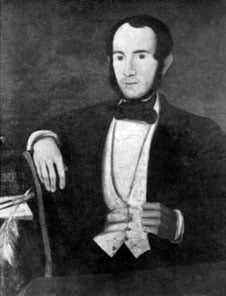Policarpo de Balzola was a Basque mathematician and inventor from Irun, Spain. He only received an elementary school education, supplemented with some geometry, trigonometry, and drawing lessons acquired from a military engineer.
Policarpo de Balzola managed a model farm in the vicinity of the Court from the early 1830s to 1835. In Irun, he held various positions, including notary and secretary of the city. From 1847 to 1850 he served as an expert surveyor in Tolosa. He also served in the National Militia.
But Policarpo de Balzola is best known for his inventions, including a mechanical calculator that looked like a piano, a perpetual calendar, a measuring device for surfaces, and a scoring mechanism.
Learn more about Policarpo de Balzola’s life and inventions.

Policarpo de Balzola: The Early Years
Policarpo de Balzola was born in Irun, Spain. His father, Miguel de Balzola Garamendi Emparanza y Arribalzagogesacoa, was a parish organist and his mother, María Josefa Iparraguirre, was a cloth merchant. Policarpo de Balzola had two siblings.
Policarpo de Balzola demonstrated a strong love for math and geometry, which he learned during his elementary education in his hometown. He also learned some geometry, trigonometry, and drawing from a military engineer who repaired the town’s fortifications.
Policarpo de Balzola became a surveyor expert and a notary from 1836 to 1838. He was the secretary of the City Council of Irun in 1837 and the Notary Public of Irun in 1843.
In his spare time, he invented an arithmetic machine that he presented to the court in 1847. This invention earned him special favor with the Academy of Sciences and Conservatory Arts. They asked him to come to their center, but he did not want to leave his hometown. He also invented a machine that calculated differently weighted objects in seconds and another one that tracked the twelve zodiac signs and tides. In 1852 he started writing booklets about his many theories and ideas for new inventions.
The Teclado Aritmético of Policarpo de Balzola
In the middle of 1840s the Basque mathematician and inventor Policarpo de Balzola (1813-1879), from Irún (Guipúzcoa), Spain, (see the biography of Policarpo de Balzola) invented his machine Teclado Aritmético (Arithmetic Keyboard) — a calculating machine that had the appearance of a piano (10 years before the similar Piano machine of Thomas de Colmar).
In 1846 Balzola described his machine in a manuscript (see the manuscript of Teclado Aritmético) and ordered a prototype (2 x 9 keys) in a piano factory (the wooden case with dimensions 91 x 61 cm) and blacksmith workshop in Irun. The device was presented in several publications in early 1847. In February 1847 it was presented to the Spanish Royal Court in Madrid and was highly appreciated. In June it was presented to the Academia de Ciencias (Spanish Academy of Sciences) and described in several publications, for example in the 1 April 1847, issue of the newspaper Eco de Comercio
The machine is a kind of piano with keys grouped in sections (groups) of nine. Each key represents a digit in the decimal system, so in the section (units section), the first key represents one, the second represents two, and so on up to nine: the first key of the second section (tens section) represents ten, the second represents twenty, and so on. Above each group of keys, there are small windows in which the operator can see the corresponding numbers, engraved on a resulting wheel.
The white keys are marked 1, 3, 5, 7, and 9, while the black keys are marked 2, 4, 6, and 8. There is no key for zero.
Pressing a key puts in motion a gear wheel, thus entering the corresponding digit into the machine. There is a tens carry mechanism, to pass the motion to the next gear wheel during the transition from 9 to 0.

Balzola intended to modify the initial prototype, in order to be suitable for multiplication and division and to add an additional mechanism for the calculation of fractional numbers, but the modified prototype was destroyed in a fire. The inventor was unable to recreate the machine, because of his limited financial resources.
The image featured at the top of this post is ©Unknown author / public domain


